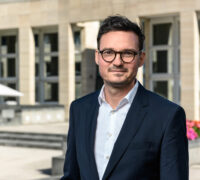
(Test-Buhle) How to get sustainable business transformation right
Sustainable business transformation is a difficult act to pull off. Julia Binder identifies the roadblocks and the drivers of change to enhance your chances of success. ...

by Heather Cairns-Lee, Alexander Fleischmann Published March 24, 2025 in Brain Circuits • 3 min read
A client is late for a meeting. On arrival, she says, “I’m sorry, my assistant told me to leave earlier because of the heavy traffic but I just couldn’t make it!” You respond, “Well, she was right, the traffic is really bad!”
This is an example of automatic association – you unthinkingly associated the word “assistant” with a woman, because women have traditionally occupied support roles. Try using more gender-neutral language, e.g., “They were right.”
In a meeting, you say “We need fresh young minds for this project.” You realize that your language is ageist but, to avoid discomfort, you carry on talking without skipping a beat.
This is an example where fear of causing embarrassment (by correcting your associating fresh minds with youth) can exacerbate a culture of not admitting mistakes or the role that language plays in stereotyping people. It’s crucial for leaders to admit mistakes and to be curious about the impact of language on culture.
In your comprehensive handbook for inclusive communication, you refer to “the disabled.”
Referring to “the disabled” is labeling and can be seen as dehumanizing – it characterizes individuals with disabilities as a homogenous group who are primarily defined by having a disability. Consult with the Employee Resource Group (ERG) on disabilities and neurodiversity or a trusted colleague regarding more appropriate terminology.
Inclusive language is a deliberate practice to check assumptions and stereotypes about gender, race and ethnicity, sexual orientation, age, ability, and other dimensions of diversity. Try using the R-E-A-L approach (Recognizing, Exploring, Acknowledging, and Learning) to create a culture of curiosity.
If you use exclusionary language, acknowledge that you made a mistake. Recognize that your choice of words may have offended, then rephrase using a more inclusive alternative.
When referring to individuals, groups, or geographic regions, identify the terms preferred by those you’re addressing by consulting them. The preferred terminology often centers on the people and not on their characteristics, e.g., people with disabilities. This avoids the use of labels such as disabled, autistic, etc., and humanizes the individual.
All words come with a history, but the history of some words is rooted in sexism, racism, ableism, homophobia, etc. Staying curious about the origins and associations of words and listening attentively broadens your understanding of how language can divide or include.
Remain open to different perspectives. Rather than shutting down a conversation because you’re afraid of saying the wrong thing, your role is to open the discussion.
Like any cultural change, a commitment to creating a more inclusive organization must come from the top. Inclusive leaders role model how to listen and challenge assumptions when it comes to inclusive communication to make the workplace welcoming for everyone to thrive.
From getting it right, to being REAL. A guide to inclusive communication for executives
Inclusive Language and Images (White paper by IMD in collaboration with EqualVoice)
The theory of equality will change the workplace forever
Cut bias to unlock your team’s potential across the spectrum

Affiliate Professor of Leadership and Communication
Heather Cairns-Lee is Affiliate Professor of Leadership and Communication at IMD. She is a member of IMD’s Equity, Inclusion and Diversity Council and an experienced executive coach. She works to develop reflective and responsible leaders and caring inclusive cultures in organizations and society.

Equity, Inclusion and Diversity Research Affiliate
Alexander received his PhD in organization studies from WU Vienna University of Economics and Business researching diversity in alternative organizations. His research focuses on inclusion and how it is measured, inclusive language and images, ableism and LGBTQ+ at work as well as possibilities to organize solidarity. His work has appeared in, amongst others, Organization; Work, Employment and Society; Journal of Management and Organization and Gender in Management: An International Journal.

May 8, 2025 • by Julia Binder in Brain Circuits
Sustainable business transformation is a difficult act to pull off. Julia Binder identifies the roadblocks and the drivers of change to enhance your chances of success. ...

April 24, 2025 • by Nicola Pless , Thomas Maak in Brain Circuits
Every leadership approach has its pros and cons. Recognizing your style and knowing how to blend different approaches – and avoid the traps – will improve your ability to respond to challenges...

April 23, 2025 • by Michael D. Watkins in Brain Circuits
Most senior leaders struggle with the decision to step down, often holding on long after their optimal departure date. Take this quiz to find out if you’re really ready – and read...

April 17, 2025 • by Alexander Fleischmann in Brain Circuits
A recent survey by IMD, Microsoft, and Ringier reveals that just 35% of organizations have strategies to address diversity bias in GenAI. Alexander Fleischmann identifies the risks and suggests ways to mitigate...
Explore first person business intelligence from top minds curated for a global executive audience